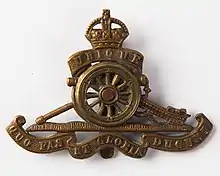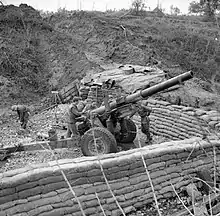1st Army Group Royal Artillery
1st Army Group Royal Artillery was a brigade-sized formation organised by Britain's Royal Artillery during World War II to command medium and heavy guns. It served in the final stages of the Tunisian Campaign and throughout the Italian Campaign. It reformed in the Territorial Army in the 1950s to command air defence units.
| 1st Army Group Royal Artillery | |
|---|---|
 Royal Artillery cap badge (pre-1953) | |
| Active | 24 August 1942 – 1 January 1947 31 May 1955 – 4 October 1961 |
| Country | |
| Branch | |
| Role | Artillery headquarters |
| Garrison/HQ | Glasgow |
| Engagements | Tunisian campaign Italian campaign |
History
Background and formation
The need for a higher organisational command structure for medium and heavy artillery became apparent during the Battle of France and the early part of the Western Desert Campaign. The 'Army Group Royal Artillery' (AGRA) concept was developed during Exercise 'Bumper' held in the UK in 1941, organised by the commander of Home Forces, General Alan Brooke (himself a Gunner) with Lt-Gen Bernard Montgomery as chief umpire.[1][2] This large anti-invasion exercise tested many of the tactical concepts that would be used by the British Army in the latter stages of the war. The gunnery tacticians developed the AGRAs as powerful artillery brigades, usually comprising three medium regiments and one heavy regiment, which could be rapidly moved about the battlefield, and had the punch to destroy enemy artillery with counter-battery (CB) fire. AGRAs were provided to field armies at a scale of about one per Army corps.[3][4][5] AGRAs were improvised until 26 November 1942, when they were officially sanctioned, to consist of a commander (CAGRA) and staff to control non-divisional artillery.[6][7]
World War II

The Headquarters (HQ) of 1st AGRA was formed at Hamilton Park, Glasgow, on 24 August 1942.[8][9][10] It was assigned to First Army for the landings in North Africa (Operation Torch), and arrived in Tunisia in January 1943, together with 56th Heavy Regiment, equipped with 7.2-inch howitzers – the first heavy regiment of the RA to serve overseas since the Dunkirk evacuation in 1940. 1st AGRA went into action in February in support of XIX French Corps with one heavy, three medium and three field regiments under command. Later it supported V Corps in the closing stages of the campaign.[9][6] It then prepared for the Allied invasion of Italy.

The make-up of an AGRA during the Italian Campaign was extremely flexible: it could include army field regiments (25-pounders), medium regiments (4.5-inch or 5.5-inch guns) and heavy regiments with 7.2-inch howitzers. It might also be augmented with 3.7-inch heavy anti-aircraft (HAA) guns loaned by the AA brigades for additional ground support fire.[11]


1st AGRA landed in Italy in October 1943, operating with V Corps again, this time under Eighth Army.[9] For V Corps' attack on the Sangro in November 1943, 1st AGRA contributed 51st (Midland) Medium Regiment alongside the guns of 6th AGRA for a massive artillery concentration.[12] It transferred temporarily to X Corps in February 1944, operating on the River Garigliano.[9]
Both 1st and 6th AGRAs supported XIII Corps in July 1944 as it approached the Gothic Line. This time the front was so wide that control of the medium guns had to be decentralised to the individual divisions, so the two AGRAs only retained two medium regiments in addition to their two heavy regiments.[13] However, when the 2nd New Zealand Division attacked on 29 July, it was supported by a concentration including the field artillery of 6th South African Armoured and 8th Indian Divisions as well as 1st AGRA, which was responsible for coordinating CB fire.[14] 1st AGRA was assigned to V Corps for the assault on the Gothic Line (Operation Olive) in August 1944, and remained with it for the rest of the war.[9][15]
1st AGRA fought at the Battle of the Argenta Gap in early 1945, ending the war at Padua.[9]
Postwar
On 1 January 1947, 1st AGRA merged with 3rd AGRA as 3 AGRA (Field) in Central Mediterranean Forces, but was disbanded by late October that year.[8][10]
at Troon, Ayrshire, between 24 April and 31 May 1955 by converting 68 Anti-Aircraft Brigade (the wartime 42nd AA Brigade at Glasgow) after Anti-Aircraft Command had been abolished on 1 March.[8][16][17] It joined British Army of the Rhine as a Corps artillery HQ in 1958. In 1959 1 AGRA Signal Squadron of the Royal Corps of Signals was redesignated 218 Signal Squadron. On 19 September 1960 1 AGRA was redesignated 1st Artillery Brigade at Hildesheim, and 218 Signal Squadron was disbanded (a new squadron with the same number as reformed in 1969).[18]
Insignia
1st AGRA's formation badge was a shield in the RA colours of blue and red, divided vertically, with a vertical yellow cannon barrel superimposed in the centre; this was also used by 3 AGRA (Field) in 1947. 1 AGRA (Field), formed in 1955, adopted a ram's skull in black and white on a red background.[10]
See also
Notes
- Bryant, pp. 256–8.
- Doherty, p. 35.
- Buckley, p. 41 & fn 60, p. 309.
- Ellis, Appendix IV.
- Farndale, Years of Defeat, p. 99.
- Playfair & Molony, Vol IV, pp. 273, 389.
- Molony, Vol V, p. 451.
- Frederick, p. 965.
- 1 AGRA at RA 39–45.
- RA Formation badges at British Badge Forum.
- Routledge, pp. 279–80.
- Molony, Vol V, p. 490.
- Jackson, Vol VI, Pt II, p. 90.
- Jackson, Vol VI, Pt II, p. 92.
- Jackson, Vol VI, Pt II, p. 225.
- Frederick, p. 1051.
- 67–106 AA Brigades at British Army 1945 on.
- Lord & Watson, p. 90.
References
- Sir Arthur Bryant, The Turn of the Tide, 1939–1943, London: Collins, 1957.
- John Buckley, Monty's Men: The British Army and the Liberation of Europe, London: Yale University Press, 2013, ISBN 978-0-300-13449-0.
- Richard Doherty, Hobart's 79th Armoured Division at War: Invention, Innovation and Inspiration, Barnsley: Pen & Sword, 2011, ISBN 978-1-84884-398-1.
- Maj L.F. Ellis, History of the Second World War, United Kingdom Military Series: Victory in the West, Vol I: The Battle of Normandy, London: HM Stationery Office, 1962/Uckfield: Naval & Military, 2004, ISBN 1-845740-58-0.
- Gen Sir Martin Farndale, History of the Royal Regiment of Artillery: The Years of Defeat: Europe and North Africa, 1939–1941, Woolwich: Royal Artillery Institution, 1988/London: Brasseys, 1996, ISBN 1-85753-080-2.
- Gen Sir William Jackson, History of the Second World War, United Kingdom Military Series: The Mediterranean and Middle East, Vol VI: Victory in the Mediterranean, Part I|: June to October 1944, London: HM Stationery Office, 1987/Uckfield, Naval & Military Press, 2004, ISBN 1-845740-71-8.
- Cliff Lord & Graham Watson, Royal Corps of Signals: Unit Histories of the Corps (1920–2001) and its Antecedents, Solihull: Helion, 2003, ISBN 1-874622-92-2.
- Brig C.J.C. Molony,History of the Second World War, United Kingdom Military Series: The Mediterranean and Middle East, Vol V: The Campaign in Sicily 1943 and the Campaign in Italy 3rd September 1943 to 31st March 1944, London: HMSO, 1973/Uckfield, Naval & Military Press, 2004, ISBN 1-845740-69-6.
- Brig C.J.C. Molony, History of the Second World War, United Kingdom Military Series: The Mediterranean and Middle East, Vol VI: Victory in the Mediterranean, Part I: 1st April to 4th June 1944, London: HM Stationery Office, 1987/Uckfield, Naval & Military Press, 2004, ISBN 1-845740-70-X.
- Maj-Gen I.S.O. Playfair & Brig C.J.C. Molony, "History of the Second World War, United Kingdom Military Series: The Mediterranean and Middle East, Vol IV: The Destruction of the Axis forces in Africa, London: HM Stationery Office, 1966/Uckfield, Naval & Military Press, 2004, ISBN 1-845740-68-8.
- Brig N.W. Routledge, History of the Royal Regiment of Artillery: Anti-Aircraft Artillery 1914–55, London: Royal Artillery Institution/Brassey's, 1994, ISBN 1-85753-099-3.
